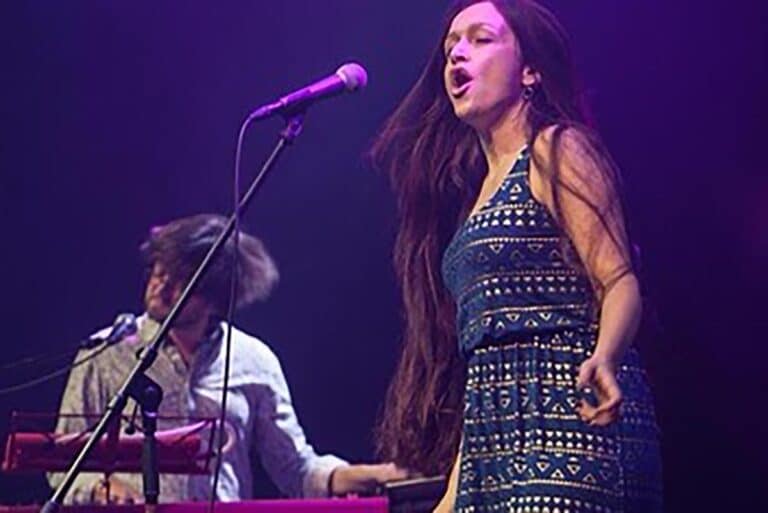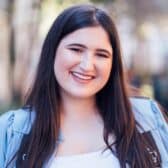
For many, klezmer music is associated with Eastern European shtetls and “Fiddler on the Roof.”
Kaia Berman-Peters is giving this old-world music genre a new spin and introducing it to a wider audience.
Berman-Peters is one of the many burgeoning klezmer fusion artists and the founder of kleztronica, which blends traditional klezmer tunes and sounds with upbeat techno music. Since December 2022, she has been hosting kleztronica shows across New York City and Boston showcasing Yiddish fusion artists as well as traditional klezmer bands.
Unpacked spoke with Berman-Peters about kleztronica, the resurgence of Yiddish culture, and the community she hopes to create with her music.
Read more: Why is Yiddish making a comeback?
What is klezmer?
Klezmer is a traditional music genre of Ashkenazi Jews that features danceable tunes, improvisation, and the use of minor keys. The genre blends Eastern European folk tunes, Jewish synagogue music and melodies of the Roma people.
The word klezmer is a Yiddish contraction of the Hebrew words for instrument (kley) and son (zemer). Klezmer’s popularity declined after the Holocaust, as European Jewish life was decimated and American Jews sought to distance themselves from shtetl culture. However, the genre experienced a revival in the 1960s that continues today with klezmer fusion artists.
Kaia Berman-Peters wanted to blend her love of klezmer and electronica music
The 23-year-old New Yorker has been involved in the klezmer scene since she was in high school when she picked up the accordion. Her father, a Jewish studies professor, hosted a wide variety of Jewish professionals in their home, exposing his daughter to the world of Jewish culture and music.
In the process, she met Jewish musician and cantor Basya Schechter, who became her mentor. Berman-Peters was inspired by Schecter’s blend of global sounds with Jewish songs and texts.
“She makes this traditional Yiddish, but also funky world music with her own spin. So she really showed me what klezmer music was,” Berman-Peters told Unpacked.
Her interest in klezmer deepened at Yiddish New York, a massive celebration of klezmer and Yiddish language.
For college, it was a no-brainer for Berman-Peters to attend the New England Conservatory of Music, known for its Yiddish revivalist movement. It was there that she rekindled her love for electronica and began to explore the fusion of klezmer with electronic music.
“I was really into electronic production as a kid because I was really into hip hop. However, in high school, it became clear to me that production was a very male-oriented field and I lost touch with it,” Berman-Peters explained. “I found much more acceptance in the klezmer scene and it aligned with my identity.”
At the conservatory, surrounded by professors skilled in both klezmer and various other genres, she was inspired to create “kleztronica,” a blend of klezmer and electronic music.
The activist roots of kleztronica
Berman-Peters, known on stage as Chaia, is drawn to Yiddish culture for its political nature.
Yiddish has historically been used as a tool to uplift workers and marginalized communities, as seen through the farming and socialist education found in historic Yiddish summer camps.
Berman-Peters aims for her kleztronica events to be spaces for music, creativity, and political activism. She hopes to inspire solidarity between Jews and other marginalized groups.
She sees parallels between Yiddish culture and the origins of house music and techno in Chicago and Detroit, both of which were deeply tied to social and cultural movements. Inspired by the practice of sampling political speeches in house music, she incorporates Yiddish speeches into her kleztronica tracks.
Her song “Utzu Ietza,” for example, includes recordings of Yiddish-speaking artists and activists such as anarchist Emma Goldman, artist Jenny Romaine, actress Molly Picon and actor Mikhl Yashinsky.
“Both house and techno were all about these political movements, social-cultural movements of Black resistance, but also queer belonging, and I really related to having music serve its cultural context. So I knew that whatever I made, it had to be very culturally oriented,” she said.
Since the revival movement began in the 1960s, Yiddish culture has become increasingly tied to queer culture.
“Queer people saw Yiddish as the space that we could fit in because it’s a space that is alternative from mainstream Jewish culture, but also a space that has been consistently open and ever-expanding with rich art and culture,” Berman-Peters said.
Creating a klezmer rave scene with kleztronica
Berman-Peters draws inspiration from klezmer musicians like hip-hop artist Josh Dolgin, who infuse electronic elements into traditional melodies. She noticed these musicians expanding on previous works and uplifting new compositions and genres, and wanted to replicate that.
For each of her shows, Berman-Peters recruits other artists who are experimenting with klezmer, whether it’s slowing down tunes, repurposing older music with new sounds, or adapting modern dances to klezmer tunes.
While the idea of a klezmer rave might sound unconventional, she believes it’s the best way to celebrate the radical traditions of Yiddish culture and electronica.
“There’s something about raves and the Yiddish world that allows for expression of queer identity and other marginalized identities. And I think that combining those is especially strong. Both of those spaces have been homes for people and I wanted to honor that,” Berman-Peters said.
So far, her experiment has seemingly paid off. Hundreds of people attend her events, and she receives daily messages from fans interested in exploring electronic music and their cultural heritage.
Reviving Yiddish culture and empowering Jewish identity
After the Holocaust, Yiddish culture suffered another decline as many Ashkenazi Jews immigrated to the U.S. and distanced themselves from “Old World” aspects like Yiddish and klezmer music in favor of “New World” culture.
In the 1950s, Hebrew schools shifted focus away from Yiddish and Ashkenazi history and culture, and instead prioritized Hebrew language and Israeli culture.
“The feeling was to move to something new, but a lot of beautiful things were lost because of that,” Berman-Peters said. “With Yiddish, we’re not going to forget about who we are. We’re going to take these things from our grandparents and our great-grandparents.”
The modern Yiddish movement aims to create spaces for alternative Jewish thinking and return to simpler, community-oriented visions of the world that were emphasized in Yiddish folk music.
Berman-Peters finds empowerment not only in delving deeper into the language and culture of her Ashkenazi Jewish heritage, but also in the strong values Yiddish culture espouses, such as community and connectivity.
Many members of Gen Z, both within and outside the Jewish community, are seeking to reconnect with their cultural roots.
Berman-Peters sees this trend reflected in the popularity of kleztronica, as people look for a new sense of belonging through their culture.
For Berman-Peters, the movement she started is bigger than just her. She aims to introduce Yiddish music to a Gen-Z audience who may not be familiar with klezmer, providing a fresh cultural context for those looking to connect with their heritage.
“People always ask me, is it a genre? Is it an event series? For me, kleztronica is a movement [that encompasses] community, practitioners, and attendees who enter the rave space and say, ‘This is the kind of community space that I want to envision.’ And I think that that’s really what a movement of ideas is.”
Originally Published Mar 15, 2024 06:11PM EDT
